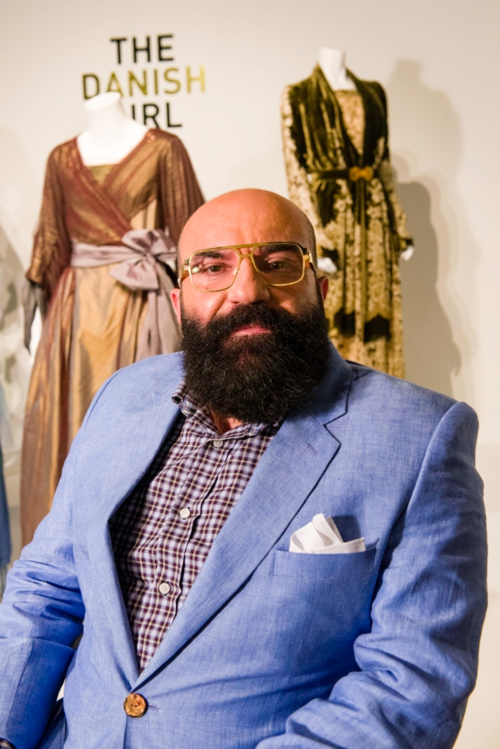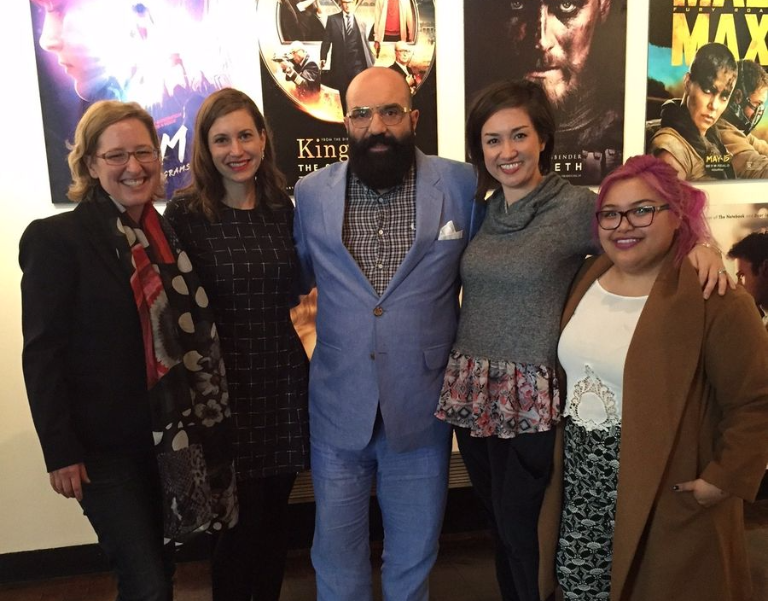Q&A with Paco Delgado
Paco Delgado was on campus today to promote his Academy Award-nominated costumes for The Danish Girl. The Spanish designer is no stranger to receiving critical acclaim; his costumes for Les Misérables in 2013 were also nominated for an Academy Award, BAFTA and Costume Designer Guild award, among others. The social media teams from the Museum, FIDM College, and Fashion Club were lucky enough to ask Delgado a few questions about the transition of his career, his process of designing for The Danish Girl, and (exciting for us!) how he used museum collections in his research.
Q: I want to take you back to the very beginning of your career. How did you get your start?
A: I actually started studying something in university completely different, I did Physics! I was always very interested in theater, especially in the visual aspects of theater. I decided to get more into the designing aspects of theater. I started being a set designer. I didn’t have any interest in costumes at all. Well, I had interest in costume but it wasn’t my main aim. What happened is I was working in very small productions and they never had any money to hire two people (basically they didn’t have money to hire one person!) I started doing sets, and then they asked me sometimes to do the costumes as well. The thing is, I always thought the costumes were like a side dish somehow to the set (I’m ashamed of that now, but that is what I thought!) And then I started doing costumes little by little, and people started to say your costumes look very interesting, and then more people started calling me for costumes, and basically I ended up doing costumes and not sets! My sets were not as good as my costumes. When I was starting I was very unaware of how difficult they were. Through years and years of working on them, I started finding them more fascinating and more interesting, and now I’m completely hooked and I really love costumes!
Q: What is it about costume design you that you think people find surprising?
A: Well, I think it is a very artistic process. A lot of people, believe it or not…you would be surprised to hear how many people think the costumes just appear on sets by miracle, or the actors bring them from home! It’s a real lack of knowledge because we try to make it so natural, that a lot of people think they just happen to be there. The first shock for a lot of people is to discover it is a designer behind it and a team making those costumes. The next level of interest is, unfortunately, nowadays is just I think us that work for shows and haute couture - we are the only people probably in the world that we still do costumes in a crafting way, doing embroidery, cutting, assembling, dying fabrics. That is a world that has died, let’s say in the main culture. It’s just like haute couture in Paris (or wherever it happens) and us in movies all over the word that we still do these things. I think that’s what a lot of people find fascinating.
Q: What is it about The Danish Girl that sparked your interest in getting involved in this film?
A: Basically the script, I just thought the whole story was very interesting, very relevant for nowadays.
Q: Absolutely – I’m sure there’s a part of you that thought your artistic choices are really going to have an impact at a time when transgender issues and gender rights are at the forefront of social and political conversation. You were going to say a lot with the choices you were making with this art. Did you think about that?
A: Well I don’t think I thought that way. I have always been a very big advocate for LGBT issues, and also I have had transgender friends in the past (and I still have), and for me it was a great opportunity to work on something I believe is a great project in a way even just to make visible the life of this amazing woman. She was fighting against society; she was a pioneer in transgender. I think it has been a really really great privilege. That is what really moved me to do this movie, apart from the fact that the director was Tom Hooper, I have worked with him in the past, and the actor was Eddie Redmayne and I have worked with him in the past as well. I have always enjoyed working with him.
Q: Did Eddie and the director have input in the decision making?
A: Well yeah because our job is a lot about compromising and having conversations, and I always think when you design costumes for an actor you have to be in a way quite humble that there might be other people with better ideas than you. And sometimes the actors come with ideas that they are actually better than anything you thought before. I really love to have an intellectual backwards and forwards about what the costumes should look like, or the fabrics, or the movements. I always think the actors have to have big input because for me it would be really horrible if I impose something that an actor doesn’t want to wear. It doesn’t go to my advantage. It is a collaboration.
Q: I read that you had Coco Chanel, Lanvin, and Paul Poiret as your inspiration for the costumes for The Danish Girl. What did you do to research their designs and their work? Did you visit a collection or libraries or anything?
A: Well I mean basically you do everything you can. You go to see collections to see the real garments, to see the fabrics. I myself am a collector. I have a really interesting collection, especially 20s, and then you know you revisit old Vogues of the period and catalogs of exhibitions and you anything you can do.
Q: You’re a collector, where do you find your pieces, where do you shop?
A: I look on the internet, auctions, just word of mouth – people say my mother, my grandmother had Chanel, maybe you’re interested to look.
Q: So you can say arts and culture and visiting these collections really inspire you.
A: Well definitely it’s very important I think as designers, as a student, to revisit what people have done in the past. It’s the key because it’s just amazing to see a garment, and if you have the opportunity, to see the garment in life. To see how it is made inside, that’s where the whole knowledge is sometimes, in the seams and construction.

